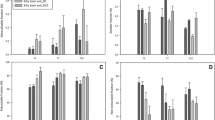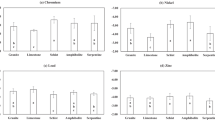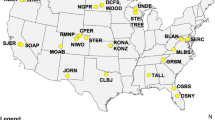Abstract
The effects of the fungicide carbendazim (applied in the formulation Derosal) on soil microarthropod communities was determined in three Terrestrial Model Ecosystem (TME) tests and a field-validation study for a period of 16 weeks after application. TMEs consisted of intact soil columns (diameter 17.5 cm; length 40 cm) taken from a grassland field. The TMEs for the two tests (pre-test and ring-test) in Amsterdam, The Netherlands, were taken from the same site where the field-validation study was performed, the third TME test (pre-test) was performed in Bangor, Wales. Collembola communities showed large variations in numbers and no effects of carbendazim on species diversity were seen. Mites were not determined to species but only to four main taxonomic groups (Astigmata, Cryptostigmata, Mesostigmata, Prostigmata). Mite numbers in both TME and field soils also showed rather large variations and it was difficult to find consistent effects of carbendazim treatment. Principal response curve (PRC) analysis was performed to further evaluate effects of carbendazim on Collembola and mites in the TME and field tests. This multivariate technique demonstrated significant effects of carbendazim on Collembola communities in one TME test and the field-validation study but not in the other two TME tests, while mite communities showed significant effects in two TME tests but not in the third TME test and the field-validation study. NOECs for the effect of carbendazim on Collembola and mite communities derived from these PRC analyses ranged from 0.36 to 87.5 kg a.i./ha.
Similar content being viewed by others
References
Al-Assiuty, A.I.M. and Khalil, M.A. (1996). Effects of the herbicide atrazine on Entomobrya musatica (Collembola) in field and laboratory experiments. Appl. Soil Ecol. 4, 139-46.
Argyropoulou, M.D., Stamou, G.P. and Iatrou, G.D. (1994). Temporal and spatial distribution patterns of Collembola in a patchy environment. Eur. J. Soil Biol. 30, 63-9.
Badejo, M.A. and Akinyemiju, O.A. (1993). Response of soil mites to hexazinone application in Nigeria. Sci. Total Environ. Suppl., 1257-63.
Balogh, J. (1972). The Oribatid Genera of the World. Budapest: Akadémia Kiad.
Begon, M., Harper, J.L. and Townsend, C.R. (1990). Ecology. Individuals, Populations and Communities. Second Edition. Boston: Blackwell Sci. Publications.
Cairns, J. (1984). Are single species toxicity tests alone adequate for estimating environmental hazard? Environ. Monit. Assessm. 4, 259-73.
Cuppen, J.G.M., Van den Brink, P.J., Camps, E., Uil, K.F. and Brock, T.C.M. (2000). Impact of the fungicide carbendazim on freshwater microcosms. I. Water quality, breakdown of particulate organic matter and responses of macroinvertebrates. Aquat. Toxicol. 48, 233-50.
Edwards, C.A., Knacker, T. and Pokarzhevskii, A. (1998). The prediction of the fate and effects of pesticides in the environment using tiered laboratory soil microcosms. The 1998 Brighton Conference-Pests and Diseases 4C-1, 267-72.
Evans, G.O., Sheals, J.G. and MacFarlane, D. (1961). The Terrestrial Acari of the British Isles. An Introduction to their Morphology, Biology and Classification. Vol. I. Introduction and Biology. The British Museum, London.
Fjellberg, A. (1980). Identification Keys to Norwegian Collembola. Norsk Entomologisk Forening. s-NLH.
Fjellberg, A. (1998). The Collembola of Fennoscandia and Denmark. Part I: Poduromorpha. Fauna Entomologica Scandinavica, Vol. 35. Brill, Leiden, Boston, Köln.
Frampton, G.K. (1988). The effects of some commonly-used foliar fungicides on Collembola in winter barley: laboratory and field studies. Ann. Appl. Biol. 113, 1-14.
Frampton, G.K., Van den Brink, P.J. and Gould, P.J.L. (2000). Effects of spring precipitation on a temperature arable collembolan community analyzed using Principal Response Curves. Appl. Soil Ecol. 14, 231-48.
Frampton, G.K. and Wratten, S.D. (2000). Effects of benzimidazole and triazole fungicide use on epigeic species of Collembola in wheat. Ecotoxicol. Environ. Safety 46, 64-72.
Gisin, H. (1960). Collembolenfauna Europas. Geneva: Museum D'histoire Naturelle.
Gulley, D.D., Boelter, A.M. and Bergman, H.L. (1991). TOXSTAT (Release 3.3. ed.). Laramie: Fish Physiology and Toxicology Laboratory, Dept. of Zoology and Physiology, University of Wyoming.
Hassan, S.A., Bigler, F., Bogenschütz, H., Brown, J.U., Firth, S.I., Huang, P., Ledieu, M.S., Naton, E., Oomen, P.A., Overmeer, W.P.J., Rieckmann, W., Samse-Petersen, L., Viggiani, G. and Van Zon, A.Q. (1983). Results of the second joint pesticide testing programme by the IOBC/WPRS-Working Group 'Pesticides and Beneficial Arthropods'. J. Appl. Entomol. 95, 151-8.
Holmstrup, M. (2000). Field assessment of toxic effects on reproduction in the earthworms Aporrectodea longa and Aporrectodea rosea. Environ. Toxicol. Chem., 19, 1781-7.
Jones, S.E., Williams, D.J., Holliman, P.J., Taylor, N., Baumann, J., Förster, B., Van Gestel, C.A.M. and Rodrigues, J.M.L. (2004). Ring testing and field-validation of a Terrestrial Model Ecosystem (TME)-An instrument for testing potentially harmful substances: Fate of the model chemical carbendazim. Ecotoxicology 13, 29-42.
Karg, W. (1993). Acari (Acarina), Milben, Parasitiformes (Anactinochaeta), Cohors Gamasina Leach. Raubmilben. Die Tierwelt Deutschlands. 59. Teil. Gustav Fischer, Jena.
Klironomos, J.N. and Kendrick, B. (1995). Relationships among microarthropods, fungi, and their environment. Plant and Soil 170, 183-97.
Knacker, T., Van Gestel, C.A.M., Jones, S.E., Soares, A.M.V.M., Schallnaß, H.-J., Förster, B. and Edwards, C.A. (2004). Ring testing and field-validation of a Terrestrial Model Ecosystem (TME)-an instrument for testing potentially harmful substances: Conceptual approach and study design. Ecotoxicology 13, 9-27.
Krogh, P.H. (1991). Perturbation of the soil microarthropod community with the pesticides benomyl and isofenphos. Pedobiologia 35, 71-88.
Marinissen, J.C.Y. and Bok, J. (1988). Earthworm-amended soil structure: its influence on Collembola populations in grassland. Pedobiologia 32, 243-52.
Morgan, E. and Knacker, T. (1994). The role of laboratory terrestrial model ecosystems in the testing of potentially harmful substances. Ecotoxicology 3, 213-33.
Römbke, J., Van Gestel, C.A.M., Jones, S.E., Koolhaas, J.E., Rodrigues, J.M.L. and Moser, T. (2004). Ring testing and field-validation of a Terrestrial Model Ecosystem (TME)-an instrument for testing potentially harmful substances: Effects of the model chemical carbendazim on earthworms. Ecotoxicology 13, 105-118.
Poole, T.B. (1962). The effect of some environmental factors on the pattern of distribution of soil Collembola in a coniferous woodland. Pedobiologia 2, 169-82.
Sheppard, S.C. (1997). Toxicity testing using microcosms. In J. Tarradellas, G. Bitton and D. Rossel, (eds). Soil Ecotoxicology, Boca Raton: Lewis Publ. pp. 345-73.
Ter Braak, C.J.F. and Smilauer, P. (1998). Canoco Reference Manual and User's Guide to Canoco for Windows. Software for Canonical Community Ordination (version 4). Ithaca, New York: Micro Computer Power, 352 pp.
Tomlin, A. (1980/1981). Effects on soil fauna of the fungicide, benomyl, used to control earthworm populations around an airport. Protect. Ecol. 2, 325-30.
Torstensson, L. and Wessén, B. (1984). Interactions between the fungicide benomyl and soil microorganisms. Soil Biol. Biochem. 16, 445-52.
Van den Brink, P.J. and Ter Braak, C.J.F. (1997). Ordination of responses to toxic stress in experimental ecosystems. Toxicol. Ecotoxicol. News 4, 173-7.
Van den Brink, P.J. and Ter Braak, C.J.F. (1998). Multivariate analysis of stress in experimental ecosystems by Principal Response Curves and similarity analysis. Aquat. Ecol. 32, 163-78.
Van den Brink, P.J. and Ter Braak, C.J.F. (1999). Principal Response Curves: analysis of time-dependent multivariate responses of a biological community to stress. Environ. Toxicol. Chem. 18, 138-48.
Van Gestel, C.A.M. (1992). The influence of soil characteristics on the toxicity of chemicals for earthworms: a review. In P.W. Greig-Smith, H. Becker, P.J. Edwards and F. Heimbach, (eds). Ecotoxicology of Earthworms, Andover, Hants: Intercept Press. pp. 44-54.
Van Gestel, C.A.M., Koolhaas, J.E., Schallnaß, H.-J, Rodrigues, J.M.L. and Jones, S.E. (2004). Ring testing and field-validation of a Terrestrial Model Ecosystem (TME)-An instrument for testing potentially harmful substances: Effects of carbendazim on nutrient cycling. Ecotoxicology 13, 119-128.
Van Leeuwen, C.J. and Hermens, J.L.M. (eds). (1995). Risk Assessment of Chemicals. An Introduction. Dordrecht: Kluwer Academic Publishers.
Van Straalen, N.M. and Rijninks, P.C. (1982). The efficiency of Tullgren apparatus with respect to interpreting seasonal changes in age structure of soil arthropod populations. Pedobiologia 24, 197-209.
Van Voris, P., Tolle, D.A. and Arthur M.F. (1985). Experimental Terrestrial Soil-Core Microcosm Test Protocol. United States Environmental Protection Agency, Washington, EPA/600/3-85/047 PNL-5450, UC-11.
Velthorst, E.J. (1993). Manual for chemical water analysis. Department of Soil Science and Geology, Agricultural University, Wageningen, The Netherlands.
Verhoef, H.A. and Nagelkerke, C.J. (1977). Formation and ecological significance of aggregations in Collembola. Oecologia 31, 215-26.
Verhoef, H.A. and Van Selm, A.J. (1983). Distribution and population dynamics of Collembola in relation to soil moisture. Holarctic Ecol. 6, 387-94.
Vickerman, G.P. (1977). The effect of foliar fungicides on some insect pests of cereals. Proceedings 1977 British Crop Protection Conference-Pests and Diseases, 121-8.
Weyers, A. and Schuphan, I. (1998). Variation of effect endpoint parameters in a terrestrial model ecosystem. Ecotoxicology 7, 335-41.
Weyers, A., Sokull-Klüttgen, B., Knacker, T., Martin, S. and Van Gestel, C.A.M. (2004). Use of Terrestrial Model Ecosystem data in environmental risk assessment for industrial chemicals, biocides and plant protection products in the EU. Ecotoxicology 13, 163-176.
Author information
Authors and Affiliations
Corresponding author
Rights and permissions
About this article
Cite this article
Koolhaas, J.E., Van Gestel, C.A., Römbke, J. et al. Ring-Testing and Field-validation of a Terrestrial Model Ecosystem (TME) – An Instrument for Testing Potentially Harmful Substances: Effects of Carbendazim on Soil Microarthropod Communities. Ecotoxicology 13, 75–88 (2004). https://doi.org/10.1023/B:ECTX.0000012406.93004.03
Issue Date:
DOI: https://doi.org/10.1023/B:ECTX.0000012406.93004.03




